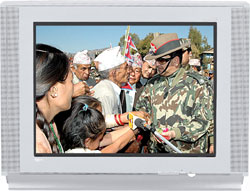|
|
These days tv news begins and ends with extensive coverage of royal excursions in the eastern region and the encounters between the monarch and his subjects are carefully orchestrated photoops.
The king in his olive greens is often shown mixing freely with impoverished Nepalis clutching at straws. King's interactions with the masses are constantly monitored by watchful guards cordoning him in multi-layered security rings.
The planned spontaneity makes for moving scenes. Figures in these acts appear to have come alive out of history books. The urban intelligentsia considers the visage of supreme commander-in-chief in every frame supremely boring. But for the bread-denied, such meticulously staged circuses are temporary diversions from the drudgery of their daily life.
The way the chairman has been doling out assurances about various projects, it's almost impossible for a resource-starved government to follow through any of them any time soon. However, whether promises made by the king can or will be kept or not is beside the point. The purpose of periodic royal trips to countryside has always been to create a distant familiarity, the kind of bond that exists between a deity and his devotees. Towards that end, King Gyanendra has brilliantly succeeded in renewing a regal tradition that goes back to the hunting trips of Ranas to tarai every winter and regular forays King Mahendra and King Birendra undertook throughout their years of absolutism.
Let there be no confusion, even though the chairman of council of ministers is not in the capital, he holds sole control over all the organs of the state. Kamal Thapa, aspiring to be His Majesty's Most Loyal Political Servant, flew out to Itahari headquarters of Eastern Command before issuing prohibitory orders against political protests and imposing nighttime curfew over almost all the heavily populated areas of the country. Earlier, the chairman himself had helicoptered into the capital for a day to clear the Budget by Ordinance issued by his government.
Roop Jyoti, the well-meaning technocrat with trading background, has been defending the budget to the best of his considerable ability, but there is little doubt that the financial ordinance is no less of a gamble than the high-stakes games being played out in the political arena. Daredevilry is written all over this half-yearly budget.
The financial plan of the government is fundamentally flawed: it disregards the principle of no taxation without representation and attempts to completely upturn the economic bases that successive popular governments since the People's Movement of 1990 had sought to build. Gone is the commitment to planned economy. The royal regime favours laissez faire, the economic model of choice for the adherents of social Darwinism all over the world. With customs duty waived, reduced, or brought to minimum, welcome to the brave new world of Nepali economy where high-spending consumers will be the new lords of the realm.
Child labour is to be regulated rather than prohibited. Foreign investment will be sought from Saudi Arabia. The government in its infinite wisdom has decided that like water, labour surplus will find its way to the low-lying areas of wage-earner shortage. In any case, when trade is to be the mainstay of economy, everyone is expected to become a shopkeeper. The shutters along Indo-Nepal border are expected to do brisk business to alleviate the shortage of Indian currency at the centre. Promotion of 'import-export' with all its connotations is the primary focus of recently promulgated financial ordinance.
Shock and awe propaganda, repress and control politics, and a funnel route for overseas trade-doesn't the combination looks distantly familiar? In case you have missed the message, it's a revised and updated edition of LOOT (Lure supporters, oppose neutralists, ostracise critics, and tyrannise the opposition) of political economy perfected through practice during the Panchayat. Rightly it has been said about orthodox societies that the more things change, the more they remain the same. But if only Nepali society were as simple as the strategists of Narayanhiti think it is.
A majority of Nepalis may still be powerless, but we know the temporariness of tyranny too well to be terrorised by it for long. It has been said of the fascist mindset that they tend to overestimate the extent of 'influence over outcomes' that is realistically possible to attain. In its bid to control everything, the palace seems to be slowly moving towards an outcome where it will be lucky to be left with anything to hold. The LOOT Model is history. No amount of political acrobatic is going to bring it back. That's the message that will start to circulate once phone lines resume.




